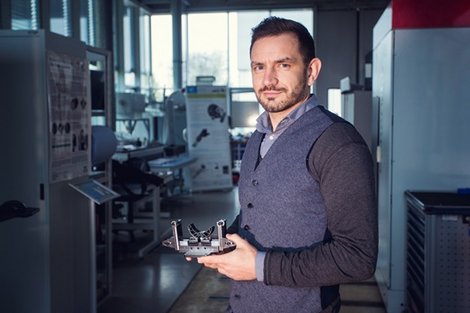Of fish and shafts

Biology meets technology: Scientists in Magdeburg use the Fin Ray effect for surface processing
A team of scientists in Magdeburg is dreaming of the perfect surface. To create it, at the Institute of Mechanical Engineering, nature is being used as a guide in order to develop brand new technical applications. “We have transferred the bionic principle of what is known as the Fin Ray effect to the processing of component surfaces,” explains Carlo Bzdok. Bzdok is a project worker in the department of Engineering Sciences and Industrial Design at Magdeburg-Stendal University of Applied Sciences.
The Fin Ray effect originated in a study by the biologist Leif Kniese, who made a fascinating discovery on going fishing: when he pressed his finger against the caudal fin of a fish, the caudal fin didn’t bend away from him but moved towards him. It clung onto the pressure-inducing body, his finger. The researcher repeated the test with other catches and all of them demonstrated the same amazing phenomenon. In the laboratory of the Berlin company EvoLogics he investigated the anatomy of the fish fins in greater detail and decoded their functioning. He finally registered the principle of the self-adaptive structure for a patent as the so-called Fin Ray effect.
By focusing on the internal structure of the fish fin and imitating its flexible configuration with technical means, it is possible to apply its principles to other areas on a creative basis. Festo, for instance, a company which is the world leader in automation technology, has developed a gripping arm featuring three fingers which adapt to the object which is to be gripped. The gripping arm is also able to securely hold breakable objects which are of differing shape. A traditional robot arm would not be sufficiently sensitive to do this.
It was at this point that the work of Magdeburg-based scientist Carlo Bzdok stepped in. Together with a team led by Prof. Harald Goldau, he is focusing on the production of functional surfaces such as those found on cylindrical components including gear shafts, crankshaft and camshafts. Rather than a conventional polishing process, so-called finishing is used as the final process in the industrial laboratory for the mechanical processing of these components. “This machining process ensures that specific properties (dimensions, shape, roughness and structure) can be allocated to the surface according to the application," explains Bzdok, who also holds a degree in industrial engineering. “We achieve the high degree of shape and dimensional accuracy due to the fact that the component is in surface contact with the tool (the finishing tape). In this respect, it is possible to say the following: the larger the surface to which the pressure is applied, the higher the attainable levels of quality."
Until now, the finishing tape has been applied using fixed pressing elements which constitute a negative mould of the shaft diameter which is to be processed. The Magdeburg-based scientists have now developed a flexible pressing element in which two so-called fingers replace the negative mould. It is these fingers that use the Fin Ray effect. “The advantage here is that this new pressing element can be used to process shafts with different diameters in a machine that has one and the same attachment. Once the invention which he has patented together with Prof. Harald Goldau and Rolf Hockauf has proven its value, it is likely to be of major benefit to industry. “The machines won't require constant retooling, saving time and money and ensuring more effective work,” explains Bzdok.
It is likely to take some time before this step is achieved, however. The scientists have more work to do on their invention. A research project that was funded by the German Federal Ministry of Economics and Energy as part of the Central Innovation Programme for Medium Sized Companies (ZIM) was recently discontinued, and the invention is not sufficiently advanced to be usable by a mechanical engineering company. “Unfortunately, our prototype for a flexible pressing element failed to pass its first case-of-use in a company at the industrial level. We will need to reconfigure the design and revise its integration in the pilot machine. “Perhaps we will succeed in using it in a different project,” says Carlo Bzdok in hope, who is also working on optimising the surfaces of artificial knee and hip joints. He hopes that the invention which hails from Magdeburg will soon find use at the industrial level. “Ideas that don't turn out to be an immediate success and learning from setbacks are part of everyday life in the world of research. It is simply part of the natural order of things and the turning of the seasons.”
Author: Dana Toschner
Photo: Matthias Piekacz
